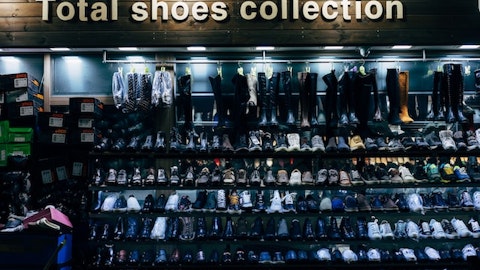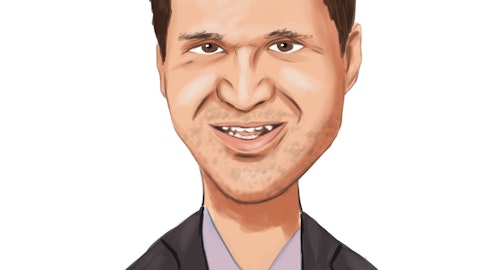So we’re very confident we’re going to hit that number. And as we stated, it’s something in progress. It will be ongoing as we move forward. We’re being very careful here in to continue to deliver great product assortment to our stores and continue our strong margins. And we believe we form to get there by the end of the year.
Sam Poser: Okay. And then — can you tell us what your store productivity was year-over-year. And also, you had guided Shoe Station to be up low double digits prior for the year. Where does that stand now?
Mark Worden: Thanks, Sam. Store productivity has progressed dramatically like I said, in each over the past 5 years. Revenues per store are approaching the highest they’ve ever been. They won’t touch the high watermark of the singles and twos 21 and 22 but they’re uplifting percent from one way or midst of the last time we had 400 doors. And more importantly, the profit has just been transformational. Now that we’ve completed the modernization and half our fleet conversion is strong and the response was outstanding. Profit per 400 doors now is up over 40%, as I said, compared to when we were in the midst of the program. Neither sales or productivity are going to touch the high watermark near term of the stimulus years, we’re incredibly pleased with where it’s grown over the long term.
In terms of Shoe Station, it’s accelerating. We could be more pleased with the integration, with the synergies, with the margin capture and with the customer response to that incredibly fresh performance running portfolio, it’s been spectacular. When you look at where it’s been, as I said in my prepared remarks, we started to see growth in Q2 meaningfully and it accelerated throughout Q2 and climbed into the mid-teens in Q3. We’re not breaking out specific guidance, but we’re expecting in this very difficult context, the Shoe Station is going to grow this year and buck the trend in the challenging retail environment.
Sam Poser: So I just want to walk through something here. You feel great about everything. You’ve cut your EPS guidance by 16%. You’ve cut your revenue guidance by 3-plus percent after cutting last quarter as well. So you seem to feel based on what you’re saying, a lot better than the results are telling us right now. And I think everybody wants to sort of put that balance that against your confidence what’s really going on and what you need to do to fix the business right now rather than just saying it’s macro stuff.
Mark Worden: Yes, at — so we do feel really good about our underlying business and the improvements we’re seeing through the year. As I said many times in my prepared remarks, we’re having difficulty with store traffic and particularly in urban markets. We don’t see that measurably improving in the balance of the year, and therefore, we are taking a measured approach on that dimension. When you look at the other side, as I talked about, we’re encouraged by the more affluent customer results, whether that’s the Shoe Station, turning to meaningful growth, compared to Q1 or our affluent e-commerce shopper showing signs of improving as the year goes. Our transaction is climbing to new highs. There are so many things that are moving forward positively. But the bottom line is it’s a challenging economic market, and we do not see it getting better to a point of getting into growth during Q3 or Q4 as our guide implies. The underlying…
Sam Poser: One last thing. What percent of your overall business historically or however you want to talk about it has been sort of the moderate more urban customer that seems mostly affected? What is the — what percent of your total revenue does that business — has that business represented.
Mark Worden: Yes. So I was talking about it earlier that about historically over half of our customers and about half of the revenue comes from households under 50,000. And — there’s a segment below that, though, which we have about double-digit percent come from the households under 30,000 households. The $30,000 per year household income. It’s that segment in particular in urban markets, the sub-$30,000 households in urban markets across the country that represent double-digit portion of our business that’s the portion that’s struggling. That’s the portion that’s giving us some traffic headwinds. It’s been moderating, as I said, Q1 double digit, Q2 mid-singles, Q3 improving, but we don’t see improving fast enough to put optimism in the back half of the year.
Simply put, until the households under $30,000 have better economic conditions, we’re going to see a headwind in our urban markets, offset by the things that are working in the nonurban markets, which I wanted to reiterate again.
Operator: We have a follow-up question from Mitch Kummetz of Seaport Research.
Mitch Kummetz : Just to follow up on that question from Sam. Does that consume that below $30,000 household income consumer, do you think you’re losing them right now to kind of the targets in the Walmarts of the world and as the macro gets better that you can kind of regain them?
Mark Worden: They’re still engaged simply, but we look at our broad CRM database that’s now over $33 million, which is over 12% growth. We can dissect that and understand who’s still engaging with us. And we’re seeing strong engagement still in under $50,000 and under $30,000 household income. But we’re not seeing them convert at the same levels as we did during ’21 and ’22. So we say active, but not converting, which says we have an opportunity to continue to engage with them as we did in Q2 as we started to back-to-school. I think best thing you saw about was reengaging those customers doing back-to-school with our broader athletic position showed very encouraging results. They still have weakness in that segment Mitch, but we continue to see improvement. We’ve seen…
Mitch Kummetz : And then with your upper income consumer where you seem to be doing better I’m also curious, do you think that some of that strength is people trading down from maybe specialty retail or the department stores? And if so, how do you retain that new customer as the macro improves?
Mark Worden: Yes. Our over $75,000 households, we saw the biggest growth in the past quarter. We’re capturing as part of our strategy is the former department store shopper, through the brand assortments and the depth of product that Carl and his organization are bringing in. We’re able to satisfy what the department store is used to as well as some family footwear that are heavily private label were instead continuing to be focused on the best brand, the depth of assortment and they’re liking what they see. That — the KPIs are working across the board for that higher-end consumer. And I do think we retain them as the mall shopper, the department store shopper and private label-focused family footwear retailers don’t have the same assortments we have.




